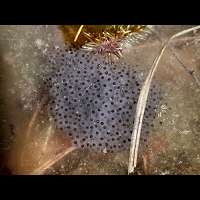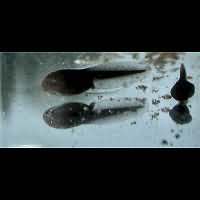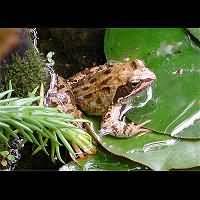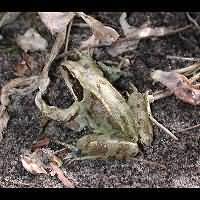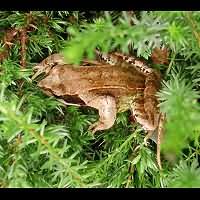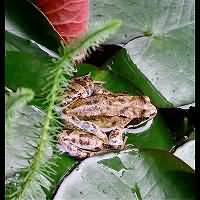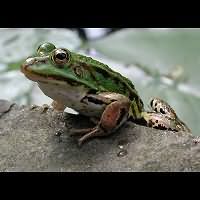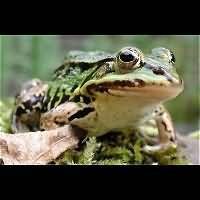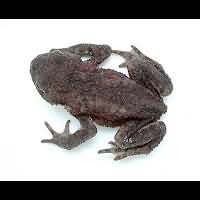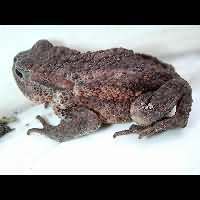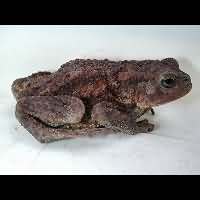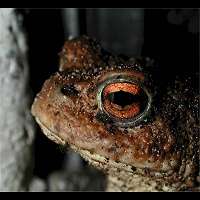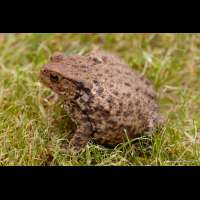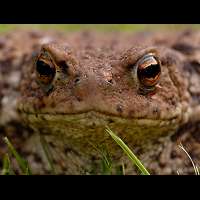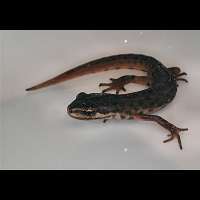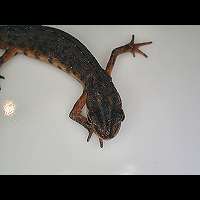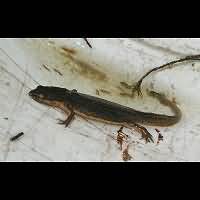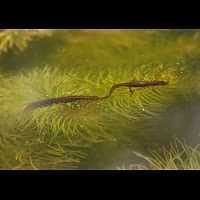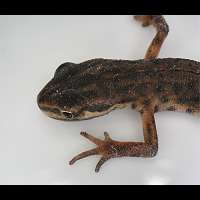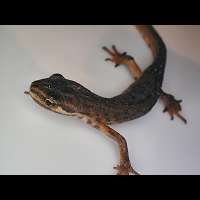[All pictures of garden wildlife on this page are thumbnails. Click on any thumbnail for a large format to be displayed.]
Amphibians are animals that do live on land, but being closely related to fish, they still need water to mate and to deposit their eggs in. During the first stage of their lives amphibians do not look like their adult parents, but rather like fish. They can only live in water, not on land. They even got gills to take oxygen from the water directly. These larvae have a tail and no legs. In a number of stages they slowly change: legs appear, in frogs the tail gets shorter with every change, and finally the gills disappear and the animal has to get out of the water and onto the land to live on. The larvae are known as tadpoles, polliwogs or pollywogs.
The beginning of a frog's life: frog jelly and tadpoles.
In cooler parts of the world though the animal may return to the water to hibernate, even though hibernating may also take place ashore. The skin of amphibians must be kept moist at all times, when it dries out the animal will soon decease. That it is the main difference between amphibians and reptiles: the skin of a reptiles is strong and can withstand heat and dry circumstances. In evolution that proofed a big advantage over the delicate skin of the amphibians. And that's why amphibians never played a predominant role on earth, while the reptiles did (dinosaurs were reptiles as well!). In Europe there are two types of amphibians: those that keep their tail: newts, and those that do not have a tail once adult: frogs and toads.
Contents: 1 frogs, 2 toads, 3 newts.
![]()
It's easier to see the Common Frog. It hibernates in our pond each year, but leaves quite early in spring. It's less bound to water than the Edible Frog and you can find it all over your garden. The species is brown mainly, like in the picture on the left, but sometimes you come across a rather green specimen, like the one in the right picture. In that case it looks like the edbile frog very much. Yet there is an easy way of telling the two species apart: The Common Frog has a dark brown spot on its cheeks, between the eye and the shoulder, which you will hardly ever see on the Edible Frog, and when it does have a brown spot there it is much smaller and of a lighter colour.
The Common Frog (Rana temporaria), showing off its brown spot.
In the Low Lands of Europe (Holland and Belgium) there used to be an abundancy of Common Frogs, but there are less of them nowadays. The biggest problem seems to be the lowering of the level of ground water. Often done to please farmers the effect on nature is absolutely negative. Luckily measures are now taken to minimize the problem and we still don't have to worry about the number of frogs: there are still lots of them. Compared to his green nephews the Common frog awakes earlier (february or March) and makes less noise.
The Common Frog is active as soon as winter is over: sometimes by the end of February!
The main species in our garden is that of the Edible Frog, also known as Green Frog. It hibernates in our pond in great numbers (well over 15 individuals) and always remains in the direct vicinity of the pond. The species is bound to water much more than the Common Frog is. The females look like they are supposed to: they are mainly green, without much variation. The males on the contrary can be a very dark kind of green, almost brown and then can be mistaken for Common Frogs, but luckily they always lack the brown cheeks. The female of the Edible Frog is almost entirely green. She remains that way during the whole year. The males are almost the same, though a bit darker perhaps, but during the mating season they develop dark spots which appear almost golden at times, as can be seen in the picture to the right below. Even though they croak, European frogs don't make as irritating a noise as some of the imported American frogs do.
The Edible Frog (Rana esculenta): a female on the left and a beautiful male on the right.
Frogs are extremely voracious and will do crazy things just to get a bite to eat, such as sudden high jumps, or sneaking through the water. They have a very long, sticky tongue. With it they mainly catch flying insects. They also like damsel flies, which they catch by surprise. The damsel flies are especially vunerable during the depostion of the eggs. Frogs are on the menu of many other animals. In the Benelux they are especially appreciated by some big birds: storches and herons love frogs. Even some birds of prey eat frogs, such as the Marsh Harrier. Frogs are not attacked from above only. Dangers even lure under water: big fish, such as pike and perch will eat a frog given the chance. On land the situation does not improve: adders and polecats are just two of the animals fond of frogs. Frogs are quickly disturbed by sudden movements. When you appear at our pond, they will all jump into the water. But if you don't move, you can soon see them climbing out of the water again. That's why herons move so slowly...
As long as you don't make sudden movements, you can get close to frogs.
Press the play button to hear the frogs quack
Toads do look like frogs very much. Most of them are not as elegantly built. Their hind legs are much weaker than those of the frog and consequently they do not jump as well as frogs do. Toads have a dry, rough skin, often with lots of warts. This skin is capable of preventing drying out much better than the frog's. Toads therefor live in much dryer environments, often far away from water, such as woods, heather etc. Most toads are nocturnal animals, this in contrary to frogs , mainly hunting in daylight. When threatened some toads produce a very stinking stuff from glands on their body making them unappealing for most enemies. Thus there are no edible toads. So far the only species regularly visiting our garden is the Common Toad.
The Common Toad (Bufo bufo) is a frequent garden visitor, but rarely ever seen, because it is a nocturnal animal.
Male common toads are much smaller than the females. The males are some 8 centimeters (3.1"), while the females may reach some 13 centimeters (5.1"). In March toads mate and the eggs are deposited in water. Toads often travel a long time to reach that water, often being the same where they were born themselves. Often the males cling to the females back and have themselves carried by her much bigger body. The eggs are not deposited in lumps like frogs do, but in (long) lines. The larvae remain very small indeed and leave the water in June or July. Young toads often stay together the entire first year. It takes them four years to become adults anyway.
To the left a rather young Common Toad. To the right the head of a female.
Toads may live for a rather long time: some 10 to 15 years! Even though toads are poor at jumping, they are excellent in swimming and digging. Hibernation starts very early indeed: in september or october toads dig a hole under a log or among the roots of trees and disappear from sight. But hibernation also ends extremely early: by the beginning of March toads are active again. Common Toads eat insects and snails.
The adult female can hardly be called gracious.
It is hard to tell the difference between newts and frogs should you be looking at the head only. Still one difference is very clear indeed: newts keep their tail, while frogs lose it once adult. In most part of Europe newts have a bad time. Many species are endangered. There is one clear exception, though: the Common Newt does allright. It is tolerable towards the quality of the water it lives in and doesn't need vast lakes to survive. A small garden pond often is quite satisfactory and there are plenty of those. But ditches, puddles and brooks are fine as well and even brackish waters will do.
The Common Newt (Triturus vulgaris) is small and unconspicuous species.
The Common Newt, also known as Smooth Newt or Brown Eft, only spends a portion of its life in water, for in summer, autumn and winter it lives on land exclusively. Male and female look alike during these parts of the year: brown or dark olivegreen on top and a lighter speckled underside. After hibernation the female doesn't change much. The male however becomes much more contrasting, having an orange underside. The animals now hurry towards the water in order to mate. During this short period of time a lot of the natural shyness is lost and often one sees the animals actively swimming about, only an inch below the surface. The animals are especially active during hours of daylight. This is amazing, for as soon as they leave the water, usually in June, they become nocturnal animals again, seldomly seen during daytime, except after some very heavy rains. In our garden we see them every spring. When cleaning the pond, it is not unusal one of our little friends is caught in the drab.
In spring the Common Newt is far from the shy animal it usually is.
Mating season starts in March and lasts quite a long time, some 3 months. Frogs often deposit their eggs in big lumps and some toads in long lines, newts deposit their eggs individually and attach them to waterplants. The larvae quickly hatch and remain extremely small, for their length never exceeds 3 centimeters. After two or three weeks the front legs appear and some two weeks later the hind legs. A newt has four fingers and five toes. Once adult the males grow to some 7 to 8 centimeters, females usually are one centimeter longer. In captivity newts may reach the age of 19, quite incredible for such a small creature! Luckily this is still a very common species all over Europe, including all of the British Isles. By the way, the scientific name of this species has recently be changed to Lissotriton vulgaris.
Apart from the tail, newts don't differ much from frogs and toads.


© Copyright 1998-2024 gardensafari.net (Hania Berdys)

 English / engels
English / engels  Dutch / nederlands
Dutch / nederlands